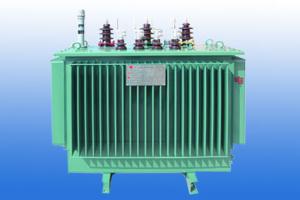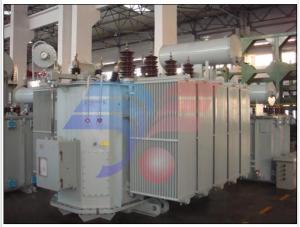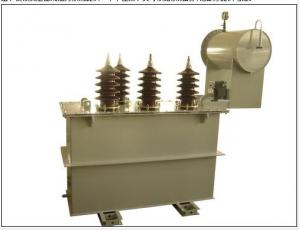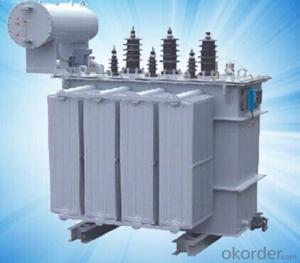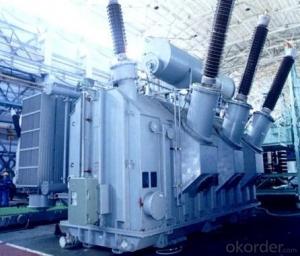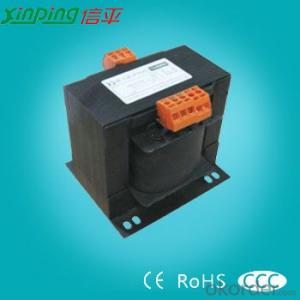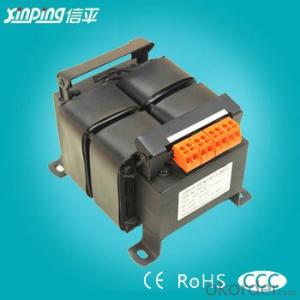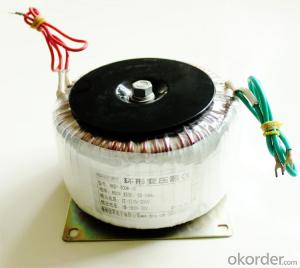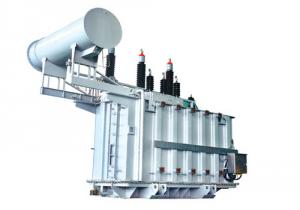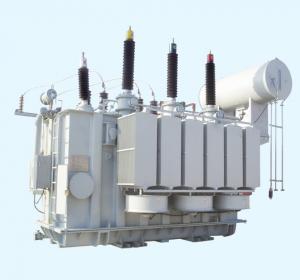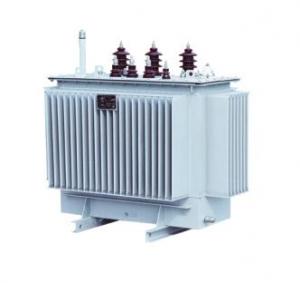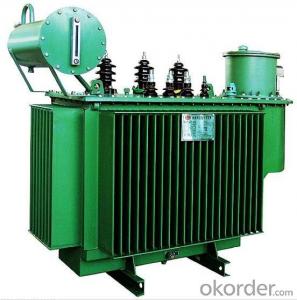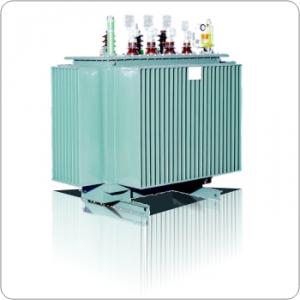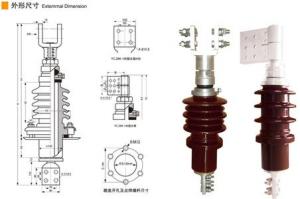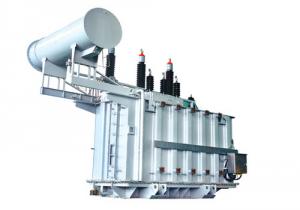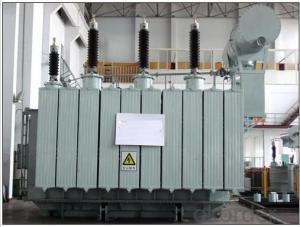Class 10KV S9-M series full-sealed transformer
- Loading Port:
- Shanghai
- Payment Terms:
- TT OR LC
- Min Order Qty:
- -
- Supply Capability:
- 1000sets set/month
OKorder Service Pledge
Quality Product, Order Online Tracking, Timely Delivery
OKorder Financial Service
Credit Rating, Credit Services, Credit Purchasing
You Might Also Like
| ted capacity (KVA) | Voltage | connection group tab | Loss | unload current(%) | resistant voltage | weight | Measure(MM) | Distance of Din rail | |||||||
| high-voltage(kv) | extend connection | low-voltage(kv) | unload | load | empty weight | oil weight | total weight | length(L) | width(W) | height(H) | cross(M)×length | ||||
| 20 | 6 | ±5% (±2×2.5%) | 0.4 | Yyn0 or Dyn11 | 105 | 480 | 3.0 | 4 | 135 | 75 | 280 | 1075 | 695 | 910 | 350×350 |
| 30 | 130 | 600 | 2.1 | 175 | 85 | 335 | 1105 | 700 | 950 | 400×450 | |||||
| 50 | 170 | 870 | 2.0 | 215 | 75 | 360 | 775 | 775 | 945 | 400×450 | |||||
| 63 | 200 | 1040 | 1.9 | 275 | 105 | 470 | 1170 | 720 | 1065 | 400×450 | |||||
| 80 | 250 | 1250 | 1.8 | 280 | 90 | 455 | 820 | 820 | 980 | 400×450 | |||||
| 100 | 290 | 1500 | 1.6 | 315 | 95 | 500 | 820 | 820 | 1005 | 400×450 | |||||
| 125 | 340 | 1800 | 1.5 | 365 | 105 | 580 | 850 | 850 | 1045 | 400×450 | |||||
| 160 | 400 | 2200 | 1.4 | 425 | 110 | 660 | 1135 | 1135 | 1075 | 550×550 | |||||
| 200 | 480 | 2600 | 1.3 | 500 | 130 | 775 | 1190 | 1190 | 1120 | 550×550 | |||||
| 250 | 560 | 3050 | 1.2 | 595 | 150 | 915 | 1215 | 1215 | 1140 | 550×550 | |||||
| 315 | 670 | 3650 | 1.1 | 700 | 170 | 1075 | 1285 | 1285 | 1200 | 660×660 | |||||
| 400 | 800 | 4300 | 1.0 | 865 | 195 | 1280 | 1305 | 1305 | 1285 | 660×660 | |||||
| 500 | 960 | 5150 | 1.0 | 985 | 220 | 1490 | 1455 | 1455 | 1275 | 660×660 | |||||
| 630 | 1200 | 6200 | 0.9 | 4.5 | 1140 | 250 | 1735 | 1555 | 1555 | 1285 | 660×660 | ||||
| 800 | 1400 | 7500 | 0.8 | 1400 | 290 | 2110 | 1660 | 1660 | 1375 | 820×820 | |||||
| 1000 | 1700 | 10300 | 0.7 | 1560 | 400 | 2475 | 1685 | 1685 | 1550 | 820×820 | |||||
| 1250 | 1950 | 12000 | 0.6 | 1915 | 465 | 2985 | 1805 | 1805 | 1505 | 820×820 | |||||
| 1600 | 2400 | 14500 | 0.6 | 2330 | 530 | 3745 | 1840 | 1840 | 1690 | 820×820 | |||||
- Q: i think transformers
- Transformers hands down
- Q: Transformers have any way of cooling
- According to the requirements of the transformer selection guide, the choice of cooling method is recommended as follows: 1, oil leaching from the cold ???31500kVA and below, 35kV and below products; ???50000kVA and below, 110kV products. 2, oil-immersed air-cooled ???12500kVA ~ 63000kVA, 35kV ~ 110kV products; ???75000kVA below, 110kV products; ???40000kVA and below, 220kV products. 3, forced oil circulation air-cooled ???50000 ~ 90000kVA, 220kV products. 4, forced oil circulation water cooling ???General hydropower plant up and down 220kV and above, 60MVA and above products used. 5, forced to guide the oil circulation air cooling or water cooling (ODAF or ODWF) ?????75000kVA and above, 110kV products; ???120000kVA and above, 220kV products; ???330kV level and 500kV grade products.
- Q: I need x-mas gifts for transformer toys! Please help thank you!
- I need x-mas gifts for transformer toys! U R giving gifts to Transformers toys?, Just go to any Wal*Mart, Target, KB Toys store they have lots of Transformers toys. They have a lot of selection @ Toys R Us(2007 movie, Beast Wars, classic, Energon and more)
- Q: What is the meaning of auxiliary transformer, sub-variable and box change What is the difference (in addition to the capacity difference), how to work with, thank you
- Is a dual power supply, usually with a large transformer used as a common, small transformer used as a backup, when the circuit with the fault, cut off in use, put on the spare, the overall is a dual power supply!
- Q: I know that both at some point were comics made by Marvel and that Thundercats was animated by a japanese studio and Transformers had an original series in japan but was here in america first. That's the info I have but what is what? And please no guessing if you don't know please don't play favorites between american and japanese cartoons, ok?
- Transformers okorder
- Q: i have the 240V AC to 12V AC step down transformerwhen i connecting directly to 240V line the output is higher at about 16Vi need only 12V for my circuithow to get the exact amount of output voltage?
- This is typical of smaller transformers. They are not very efficient, and so the output voltage changes with changes in load. They are specified for voltage at the full load, so with a light load the voltage is higher. Of course the output voltage also depends on the input voltage with a transformer, and there can be measurement issues with non sinusoidal waveforms. Usually a DC supply in an appliance or device (if that is your purpose) is designed so it can accommodate the full expected range of input AC voltages. This often involves a DC regulator applied to the unregulated DC output. This leads to a DC supply with a specified range of AC input voltages. You will need to consider the range of voltages your appliance can use. This is not always specified, but it may be shown as a maximum and minimum AC voltage allowed. With more information about your circuit it should be possible to determine the maximum and minimum input voltages required. There are ways to change this to suit your transformer if the appliance circuit is known. Ways to reduce the AC voltage: Increase the load on the transformer, perhaps with a suitable lamp or heater. The total load (watts) must be less than the transformer power ratings. Near full load the voltage will be more like the specified voltage for the transformer. This assumes the normal load is much less than the transformer power rating, which is when the voltage is high. If the load varies, this method is not ideal and it wastes power. Use a second transformer or variac to adjust the AC input to the transformer. This only works if the transformer is used with a small load. This will work best with a fixed load current, and is bulky and expensive. Get a different transformer specified to supply the correct voltage at the current you are using. If the current varies widely this is not a suitable method.
- Q: Before engaging any technician i want to gather some knowledge about planer transformer. It will be good if u have any suggestions.
- While operating under the same laws of physics and using the same materials (i.e. copper, ferrites) like the conventional transformers, these Planetics? planar transformers have different construction geometry that reflects handful of technological advantages.
- Q: I need to make a small transformer (that uses AC obviously) that would boost an input voltage of 20-30 millivolts at 1.5 mA to a output voltage of 1 volt (with a current that would obviously be very small) How must I design and build the transformer to accomplish this? Thank you.
- Transformers follow Ohm's Law and multiply or divide voltages based on the number of turns making each coil. You need only ensure your two coils have the appropriate number of windings. As for actual numbers for the windings, 1.5mA is an absolutely tiny amount of current, so you have considerable flexibility in this. If you are looking to build a transformer, you should look up the information on what you're planning to use for a core, to be able to calculate the voltage across the secondary coil.
- Q: I have a few power tools, none of which are natively wired for 110-240v. In particular, a portable table saw, a router, and a mitre saw, all at 220v. Since the resale value of them are so low on auction sites, I was thinking of taking them with me when I shift home to the states. Would it be safe using those tools, for extended periods, whilst running them on a transformer?
- You can do that. Just make sure the transformer is rated for the power they will draw. Keep this in mind: American homes are wired with 220 volts. Only, they split the voltage into two 110 volt legs. Each leg to ground (or neutral) is 110 volts (also commonly referred to as 120 volts). But from one leg to the other is where you get the 220 (or 240) volts. My garage is wired with two legs of 110, which means I have 220 out there. I also have an outlet for 220 volts. Because some of the power tools I run demand more current, and run them simultaneously, the standard 110 outlets struggle to meet the demand. So what I did was to take a dryer cord and wire it into a pony panel where I can draw 110 volts from one leg to ground to power a table saw while the other leg powers the dust collection system. To try and run both those pieces of equipment on a single 110 line means a trip to the breaker to reset it because each draws enough power that when used together they draw more current than the circuit is safely rated for. YOU can do something similar. Just make sure you use a 20 amp outlet meant for use with 220 volts and wire into the panel (if not already wired) and set up a 220 volt plug where you will be using these power tools. Using a transformer will work, but the more you couple the power magnetically the more inefficient your system becomes, and you waste power. Also consider just buying tools rated at 110 volts. They're plentiful and cheap enough that the cost may offset the cost of shipping these 220 v tools. Throw in the cost of a transformer and you're probably spending more money in the long run. Hope this helps. '')
- Q: A step up transformer increases 17.7v to 120v. what is the ratio of the current in the secondary compared to primary? Assume 92% efficiency.HELP PLEASE
- Preliminary necessary comments. (i) This question - and consequently my answer - assumes that we have a perfect transformer: such a transformer will have an efficiency of 100 %. (If this was not a perfect transformer, then a great deal more data about the transformer would need to be supplied: it isn't). Hence, because the efficiency of the transformer in this question is less than 100%, that must be because a secondary current is flowing in the load, the details of which we do not know - or indeed need to know. (ii) Transformers are rated in terms of their product of volts and amps: called VA. They are NOT rated in terms of watts, since the manufacturer cannot assume that the load on the transformer secondary will have a unity power factor. (iii) When a transformer supplies current to a load, its on-load efficiency is the ratio of (VA)out to (VA)in. (VA)in primary VA; (VA)out secondary VA. Solution. Let the primary current Ip; let the secondary current Is. Let the primary voltage Vp; let the secondary voltage Vs. Let the efficiency n. Then we have: (VA)in Ip X Vp Ip X 17.7 (VA)out Is X Vs Is X 120. (VA)out n X (VA)in. so: Is X 120 0.92 X Ip X 17.7 i.e.: Is/Ip (0.92 X 17.7)/120 0.138/1 ? Hence, the secondary current is 0.138 that of the primary current. HTH, Skywave.
Send your message to us
Class 10KV S9-M series full-sealed transformer
- Loading Port:
- Shanghai
- Payment Terms:
- TT OR LC
- Min Order Qty:
- -
- Supply Capability:
- 1000sets set/month
OKorder Service Pledge
Quality Product, Order Online Tracking, Timely Delivery
OKorder Financial Service
Credit Rating, Credit Services, Credit Purchasing
Similar products
Hot products
Hot Searches
